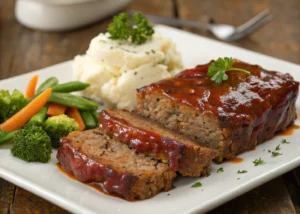
Indulge in These Delightful Plum Dumplings: A Sweet Treat That Combines Tender Potatoes with Juicy Plums!
By Jason Griffith
There’s a certain magic in traditional European desserts, and these Plum Dumplings (or “Zwetschgenknödel” as they’re often known) are a perfect example. This sweet treat masterfully combines tender, fluffy potato dough with the sweet-tart burst of juicy plums, each one hiding a little gem of rock candy or sugar. Rolled in buttery, toasted breadcrumbs and dusted with powdered sugar, these dumplings are a comforting, elegant, and utterly delightful dessert that transports you to a cozy, sun-drenched European kitchen. They’re a truly special way to celebrate the season’s plums!
Why I Love This Recipe
I have a soft spot for unique desserts, and these Plum Dumplings are a revelation. What I absolutely adore is the unexpected harmony between the savory, tender potato dough and the sweet, slightly acidic burst of the plum. It’s a combination that truly works, creating a delightful contrast in every bite. The little surprise of rock candy inside the plum adds an extra layer of sweetness and a fun element, while the buttery, toasted breadcrumbs provide a fantastic textural crunch. It feels like a labor of love, yet the steps are quite manageable, resulting in a dessert that’s both comforting and sophisticated.
Ingredients:
- 450 g starchy potatoes (like Russet or Yukon Gold)
- 130 g all-purpose flour
- 2 tbsp granulated sugar
- 30 g semolina
- 1 tsp lemon peel (finely grated zest)
- Oil for shaping the dumplings (neutral oil like vegetable or canola)
- 130 g margarine (or unsalted butter for richer flavor)
- 100 g bread crumbs (plain or Panko)
- 7 Italian plums (or other firm, small plums), washed
- 7 pieces rock candy or sugar cubes
- Powdered sugar for dusting (for serving)
Swaps and Notes
- Potatoes: Use starchy potatoes like Russet, Idaho, or Yukon Gold. They mash up light and fluffy, which is crucial for the dough’s texture. Waxy potatoes won’t work as well.
- Margarine/Butter: While the recipe calls for margarine, unsalted butter can be used interchangeably for a richer, more traditional flavor in both the dough and for toasting the breadcrumbs.
- Semolina: Semolina adds a slight chewiness and helps with the dough’s texture. If you don’t have semolina, you can substitute with an equal amount of flour, though the texture may be slightly softer.
- Sugar Cubes/Rock Candy: These melt inside the plum, creating a warm, syrupy center. If you don’t have them, you can use about ½ teaspoon of granulated sugar per plum.
- Plums: Italian plums (also known as prune plums) are ideal because of their firm flesh and easy-to-remove pits. Other small, firm, ripe plums can be used, but avoid overly juicy or soft varieties.
- Lemon Peel: Freshly grated lemon zest adds a wonderful bright, aromatic note that complements the plums beautifully.
- Bread Crumbs: Plain bread crumbs work well, but Panko bread crumbs can give an even crispier coating. You can also toast them with a pinch of cinnamon for extra warmth.
- Optional Flavorings: A pinch of cinnamon or nutmeg can be added to the potato dough for a warmer spice profile.
Directions:
1. Prepare the Plums: Start by thoroughly washing the plums. Using a small, sharp knife, carefully cut each plum halfway around its circumference, following the seam, to remove the pit. Leave them slightly open. Set the prepared plums aside for now.
2. Boil the Potatoes: Place your starchy potatoes in a large pot. Cover them with cold water, ensuring they are fully submerged. Bring the water to a boil over high heat, then reduce the heat to medium and let them boil for about 20 minutes, or until they are tender when pierced with a fork.
3. Mash the Potatoes: Once the potatoes are cooked, drain them well. While they are still hot (this is important for a smooth mash!), carefully peel them. Transfer the peeled hot potatoes to a large mixing bowl. Using a potato ricer, potato masher, or a sturdy fork, mash them thoroughly until they are smooth and free of lumps. You want a very fine, consistent mash.
4. Create the Dough Base: Add 30 g of margarine (or butter) to the hot mashed potatoes. Mix vigorously until the margarine is completely melted and incorporated, making the mashed potatoes smooth and creamy.
5. Form the Dough: Now, add the semolina, 130 g flour, 2 tbsp sugar, and 1 tsp lemon peel to the mashed potato mixture. Get in there with your clean hands and mix everything together. Knead gently until it forms a soft, slightly sticky, cohesive dough. Avoid overmixing, as this can make the dumplings tough.
6. Prepare for Boiling: Fill a large pot with about 2 liters of water (or enough to comfortably submerge the dumplings). Add a pinch of salt to the water. Bring the water to a boil over high heat.
7. Shape the Dumplings: Divide your potato dough into 7 equal pieces. To prevent the dough from sticking to your hands, rub a little oil (vegetable or canola) on your palms. Take one piece of dough and flatten it into a disk in your hand. Take one of the prepared plums and carefully stuff a piece of rock candy or a sugar cube into the cavity where the pit was removed. Place the sugar-stuffed plum in the center of the dough disk. Carefully fold the dough around the plum, pinching and sealing all seams completely to ensure the plum is fully encased and no sugar can leak out. Roll gently between your palms to form a smooth ball. Repeat with the remaining dough and plums.
8. Cook the Dumplings: Once the water is boiling, gently drop the shaped dumplings into the boiling water, being careful not to overcrowd the pot (you may need to do this in batches). Once all dumplings are in, lower the temperature to a gentle simmer. Let them simmer for about 10 minutes. The dumplings are done when they float to the surface.
9. Toast the Breadcrumbs: While the dumplings are simmering, prepare the breadcrumb coating. In a separate large pan or skillet, melt the remaining 100 g of margarine (or butter) over medium heat. Add the bread crumbs and toast them for a few minutes, stirring constantly, until they are golden brown and fragrant. Remove from heat.
10. Coat and Serve: Using a slotted spoon, carefully remove the cooked dumplings from the simmering water.Immediately transfer them to the pan with the toasted breadcrumb mixture. Gently roll each dumpling in the breadcrumbs until it is fully coated. Serve the plum dumplings warm, with a generous sprinkle of powdered sugar on top.
Tips for Success
- Hot Potatoes for Mashing: Mashing the potatoes while they are hot is essential for a smooth, lump-free mash, which translates to a tender dough.
- Don’t Overwork the Dough: Mix the dough just until it comes together. Overworking potato dough can make the dumplings dense and tough.
- Seal Tightly: Ensure each plum is completely sealed within the dough. Any opening can cause the sugar to melt out during boiling.
- Gentle Simmer: Boil the dumplings at a gentle simmer, not a vigorous boil, to prevent them from breaking apart.
- Coat Immediately: Roll the hot, cooked dumplings in the warm breadcrumbs immediately after removing them from the water so the crumbs adhere well.
- Taste Test: If using plums that are very tart, you might want to increase the sugar in the dough slightly.
Serving Suggestions and Pairings
Plum Dumplings are a delightful dessert on their own, often served warm and dusted with powdered sugar.
- Custard Sauce: A light vanilla custard sauce or crème anglaise makes a wonderful accompaniment.
- Fruit Compote: A side of extra plum compote or a mixed berry sauce.
- Whipped Cream: A dollop of lightly sweetened whipped cream.
- Ice Cream: A scoop of vanilla bean ice cream could provide a delightful hot-and-cold contrast.
- Coffee or Tea: Pair with a warm cup of coffee or herbal tea for a cozy afternoon treat.
- If you love comforting, unique desserts, you might also enjoy these Chefmaniac favorites:
- This Big Family Banana Pudding Is My Favorite Classic Dessert to Feed a Crowd
- These Chocolate Chip Cookie Dough Brownie Bombs Are My Favorite Sweet Obsession
- The Best Peanut Butter Brownies I’ve Ever Made (and I’ve Made a Lot)
- This Chocolate Chip Banana Bread Is My Favorite Way to Use Up Overripe Bananas
Storage and Leftover Tips
Plum dumplings are truly best enjoyed fresh and warm.
- Immediate Consumption: For optimal texture and flavor, serve the dumplings as soon as they’re coated in breadcrumbs.
- Refrigeration: If you have leftovers, store them in an airtight container in the refrigerator for up to 1-2 days. The dough can become a bit firmer, and the breadcrumbs less crisp.
- Reheating: Reheat gently in a microwave for a short burst (they might lose some crispness), or in a lightly oiled pan over low heat to try and re-crisp the breadcrumbs.
- Freezing: Freezing prepared dumplings is generally not recommended as the potato dough can become mealy or crumbly upon thawing and reheating.
Final Thoughts
These Plum Dumplings are a beautiful example of how simple, humble ingredients can be transformed into a truly delightful and memorable dessert. The tender potato dough, the sweet-tart plums, and the buttery, crunchy coating create a symphony of textures and flavors that are both comforting and elegant. It’s a special treat that’s well worth the effort and a perfect way to bring a touch of European charm to your table.
Have you ever tried potato dumplings before, sweet or savory? Share your experiences and any special twists you’d add in the comments below! And don’t forget to follow Chefmaniac for more unique and delicious recipes.




Leave a Reply